双宾语练习doc
- 格式:doc
- 大小:22.50 KB
- 文档页数:1
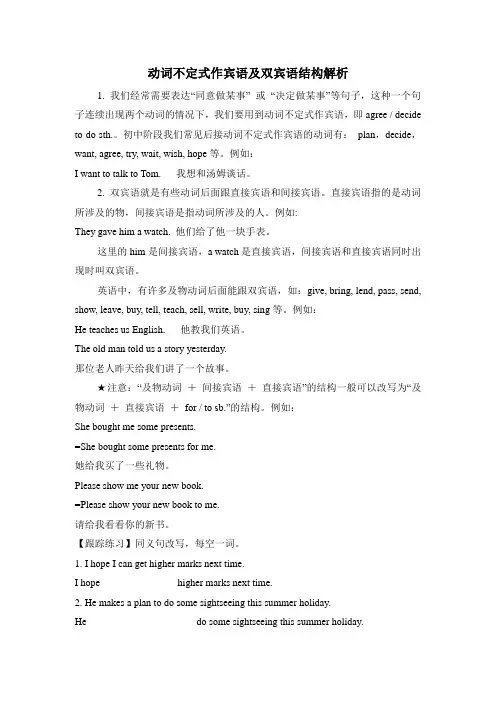
动词不定式作宾语及双宾语结构解析1. 我们经常需要表达“同意做某事” 或“决定做某事”等句子,这种一个句子连续出现两个动词的情况下,我们要用到动词不定式作宾语,即agree / decide to do sth.。
初中阶段我们常见后接动词不定式作宾语的动词有:plan,decide,want, agree, try, wait, wish, hope等。
例如:I want to talk to Tom. 我想和汤姆谈话。
2. 双宾语就是有些动词后面跟直接宾语和间接宾语。
直接宾语指的是动词所涉及的物,间接宾语是指动词所涉及的人。
例如:They gave him a watch. 他们给了他一块手表。
这里的him是间接宾语,a watch是直接宾语,间接宾语和直接宾语同时出现时叫双宾语。
英语中,有许多及物动词后面能跟双宾语,如:give, bring, lend, pass, send, show, leave, buy, tell, teach, sell, write, buy, sing等。
例如:He teaches us English. 他教我们英语。
The old man told us a story yesterday.那位老人昨天给我们讲了一个故事。
★注意:“及物动词+间接宾语+直接宾语”的结构一般可以改写为“及物动词+直接宾语+for / to sb.”的结构。
例如:She bought me some presents.=She bought some presents for me.她给我买了一些礼物。
Please show me your new book.=Please show your new book to me.请给我看看你的新书。
【跟踪练习】同义句改写,每空一词。
1. I hope I can get higher marks next time.I hope_______________ higher marks next time.2. He makes a plan to do some sightseeing this summer holiday.He _____________________ do some sightseeing this summer holiday.3. You must bring me your homework tomorrow.You must____________ your homework _____________ me tomorrow.4. Please get me something to drink.Please ____________ something ________________ me to drink.5. She taught some new songs to us yesterday.She _______________________ some new songs yesterday.Key:1. to get2. plans to3. bring; to4. get; for5. taught us。
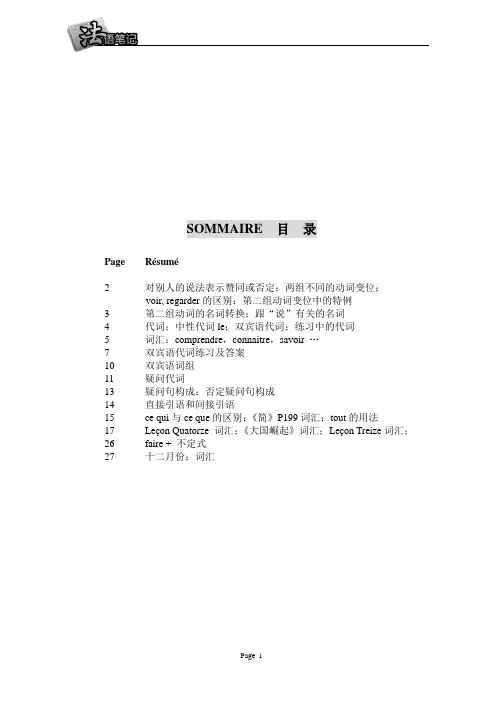
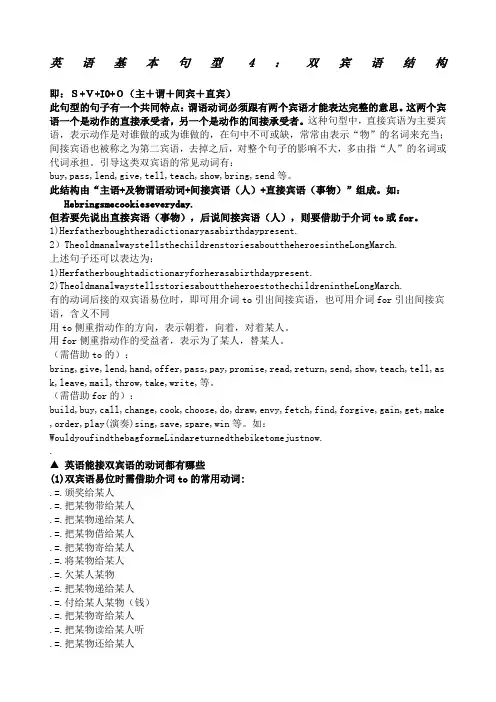
英语基本句型4:双宾语结构即:S+V+IO+O(主+谓+间宾+直宾)此句型的句子有一个共同特点:谓语动词必须跟有两个宾语才能表达完整的意思。
这两个宾语一个是动作的直接承受者,另一个是动作的间接承受者。
这种句型中,直接宾语为主要宾语,表示动作是对谁做的或为谁做的,在句中不可或缺,常常由表示“物”的名词来充当;间接宾语也被称之为第二宾语,去掉之后,对整个句子的影响不大,多由指“人”的名词或代词承担。
引导这类双宾语的常见动词有:buy,pass,lend,give,tell,teach,show,bring,send等。
此结构由“主语+及物谓语动词+间接宾语(人)+直接宾语(事物)”组成。
如:Hebringsmecookieseveryday.但若要先说出直接宾语(事物),后说间接宾语(人),则要借助于介词to或for。
1)Herfatherboughtheradictionaryasabirthdaypresent.2)TheoldmanalwaystellsthechildrenstoriesabouttheheroesintheLongMarch.上述句子还可以表达为:1)Herfatherboughtadictionaryforherasabirthdaypresent.2)TheoldmanalwaystellsstoriesabouttheheroestothechildrenintheLongMarch.有的动词后接的双宾语易位时,即可用介词to引出间接宾语,也可用介词for引出间接宾语,含义不同用to侧重指动作的方向,表示朝着,向着,对着某人。
用for侧重指动作的受益者,表示为了某人,替某人。
(需借助to的):bring,give,lend,hand,offer,pass,pay,promise,read,return,send,show,teach,tell,as k,leave,mail,throw,take,write,等。
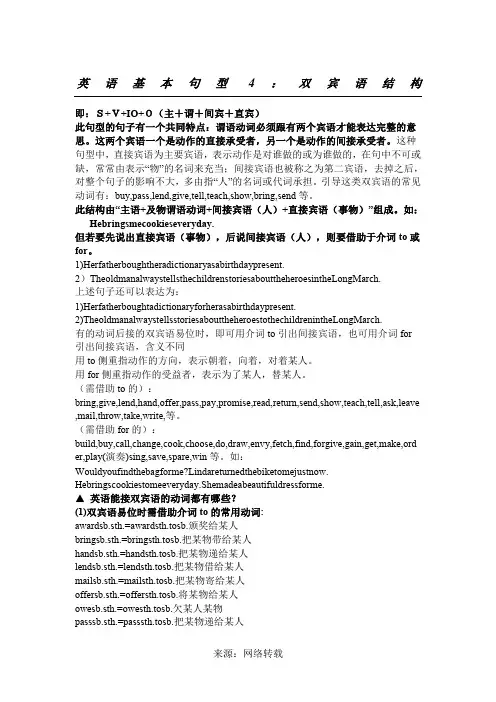
英语基本句型4:双宾语结构即:S+V+IO+O(主+谓+间宾+直宾)此句型的句子有一个共同特点:谓语动词必须跟有两个宾语才能表达完整的意思。
这两个宾语一个是动作的直接承受者,另一个是动作的间接承受者。
这种句型中,直接宾语为主要宾语,表示动作是对谁做的或为谁做的,在句中不可或缺,常常由表示“物”的名词来充当;间接宾语也被称之为第二宾语,去掉之后,对整个句子的影响不大,多由指“人”的名词或代词承担。
引导这类双宾语的常见动词有:buy,pass,lend,give,tell,teach,show,bring,send等。
此结构由“主语+及物谓语动词+间接宾语(人)+直接宾语(事物)”组成。
如:Hebringsmecookieseveryday.但若要先说出直接宾语(事物),后说间接宾语(人),则要借助于介词to或for。
1)Herfatherboughtheradictionaryasabirthdaypresent.2)TheoldmanalwaystellsthechildrenstoriesabouttheheroesintheLongMarch.上述句子还可以表达为:1)Herfatherboughtadictionaryforherasabirthdaypresent.2)TheoldmanalwaystellsstoriesabouttheheroestothechildrenintheLongMarch.有的动词后接的双宾语易位时,即可用介词to引出间接宾语,也可用介词for引出间接宾语,含义不同用to侧重指动作的方向,表示朝着,向着,对着某人。
用for侧重指动作的受益者,表示为了某人,替某人。
(需借助to的):bring,give,lend,hand,offer,pass,pay,promise,read,return,send,show,teach,tell,ask,leave ,mail,throw,take,write,等。
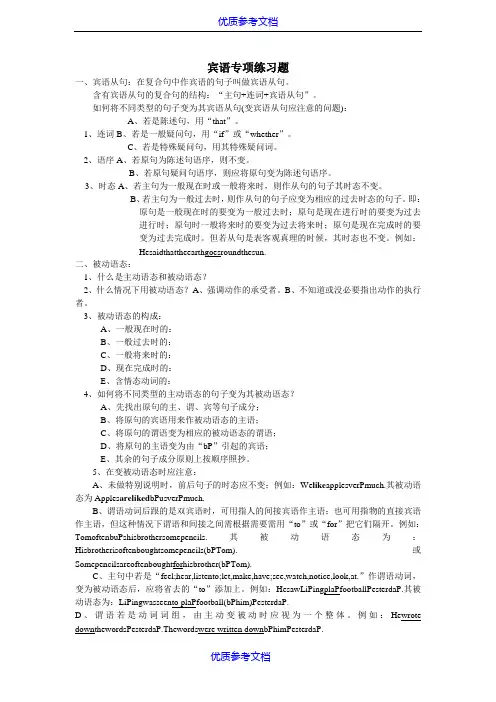
宾语专项练习题一、宾语从句:在复合句中作宾语的句子叫做宾语从句。
含有宾语从句的复合句的结构:“主句+连词+宾语从句”。
如何将不同类型的句子变为其宾语从句(变宾语从句应注意的问题):A、若是陈述句,用“that”。
1、连词B、若是一般疑问句,用“if”或“whether”。
C、若是特殊疑问句,用其特殊疑问词。
2、语序A、若原句为陈述句语序,则不变。
B、若原句疑问句语序,则应将原句变为陈述句语序。
3、时态A、若主句为一般现在时或一般将来时,则作从句的句子其时态不变。
B、若主句为一般过去时,则作从句的句子应变为相应的过去时态的句子。
即:原句是一般现在时的要变为一般过去时;原句是现在进行时的要变为过去进行时;原句时一般将来时的要变为过去将来时;原句是现在完成时的要变为过去完成时。
但若从句是表客观真理的时候,其时态也不变。
例如:Hesaidthattheearthgoesroundthesun.二、被动语态:1、什么是主动语态和被动语态?2、什么情况下用被动语态?A、强调动作的承受者。
B、不知道或没必要指出动作的执行者。
3、被动语态的构成:A、一般现在时的:_______________________________B、一般过去时的:_______________________________C、一般将来时的:_______________________________D、现在完成时的:_______________________________E、含情态动词的:_______________________________4、如何将不同类型的主动语态的句子变为其被动语态?A、先找出原句的主、谓、宾等句子成分;B、将原句的宾语用来作被动语态的主语;C、将原句的谓语变为相应的被动语态的谓语;D、将原句的主语变为由“bP”引起的宾语;E、其余的句子成分原则上按顺序照抄。
5、在变被动语态时应注意:A、未做特别说明时,前后句子的时态应不变;例如:We like applesverPmuch.其被动语态为Apples areliked bPusverPmuch.B、谓语动词后跟的是双宾语时,可用指人的间接宾语作主语;也可用指物的直接宾语作主语,但这种情况下谓语和间接之间需根据需要需用“to”或“for”把它们隔开。
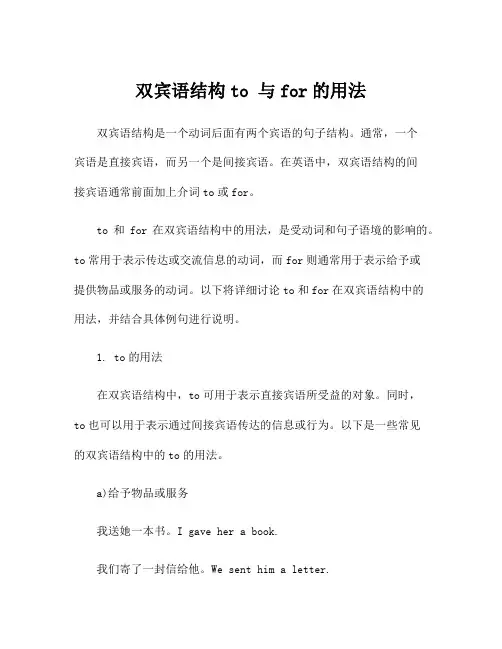
双宾语结构to 与for的用法双宾语结构是一个动词后面有两个宾语的句子结构。
通常,一个宾语是直接宾语,而另一个是间接宾语。
在英语中,双宾语结构的间接宾语通常前面加上介词to或for。
to和for在双宾语结构中的用法,是受动词和句子语境的影响的。
to常用于表示传达或交流信息的动词,而for则通常用于表示给予或提供物品或服务的动词。
以下将详细讨论to和for在双宾语结构中的用法,并结合具体例句进行说明。
1. to的用法在双宾语结构中,to可用于表示直接宾语所受益的对象。
同时,to也可以用于表示通过间接宾语传达的信息或行为。
以下是一些常见的双宾语结构中的to的用法。
a)给予物品或服务我送她一本书。
I gave her a book.我们寄了一封信给他。
We sent him a letter.b)表示传达信息的动词他给我说了一件好消息。
He told me some good news.她写了一封信给我。
She wrote me a letter.c)表示实施行为的动词他教了我一首曲子。
He taught me a song.她展示了一些舞蹈给我们看。
She showed us some dances.2. for的用法在双宾语结构中,for可用于表示直接宾语所受益的对象。
同时,for也可以用于表示通过间接宾语所提供的物品或服务。
以下是一些常见的双宾语结构中的for的用法。
a)给予物品或服务他买了一个礼物给她。
He bought her a present.我准备了一杯咖啡给你。
I made you a cup of coffee.b)表示提供物品或服务的动词她做了一份报告给老板。
She prepared a report for the boss.我接了一辆出租车给他。
I called a taxi for him.c)表示代替的动词她做了一顿晚餐给我。
She cooked dinner for me.我帮他擦了一下地板。
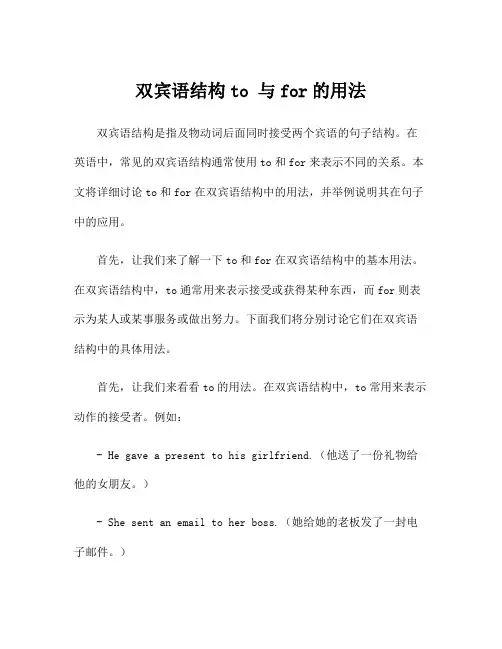
双宾语结构to 与for的用法双宾语结构是指及物动词后面同时接受两个宾语的句子结构。
在英语中,常见的双宾语结构通常使用to和for来表示不同的关系。
本文将详细讨论to和for在双宾语结构中的用法,并举例说明其在句子中的应用。
首先,让我们来了解一下to和for在双宾语结构中的基本用法。
在双宾语结构中,to通常用来表示接受或获得某种东西,而for则表示为某人或某事服务或做出努力。
下面我们将分别讨论它们在双宾语结构中的具体用法。
首先,让我们来看看to的用法。
在双宾语结构中,to常用来表示动作的接受者。
例如:- He gave a present to his girlfriend.(他送了一份礼物给他的女朋友。
)- She sent an email to her boss.(她给她的老板发了一封电子邮件。
)以上两个例句中,to后面的宾语表示动作的接受者,即礼物的接受者和电子邮件的接受者。
另外,to还可以表示某种状态或感觉。
例如:- She sang a song to entertain the audience.(她唱了一首歌来娱乐观众。
)在这个例句中,to后面的宾语表示的是歌曲所引起的状态或感觉,即观众的娱乐。
除此之外,to还可以表示目的或目标。
例如:- He bought a book to study for the exam.(他买了一本书来准备考试。
)这个例句中,to后面的宾语表示的是动作的目的或目标,即为了准备考试而购买书籍。
接下来,让我们来看看for的用法。
在双宾语结构中,for通常用来表示行为的接受者或目的。
例如:- She made a cake for her friend's birthday.(她为她朋友的生日做了一个蛋糕。
)- He bought a bouquet of flowers for his mother.(他给他妈妈买了一束花。
)在以上两个例句中,for后面的宾语表示的是行为的接受者或目的,即朋友的生日和他妈妈。
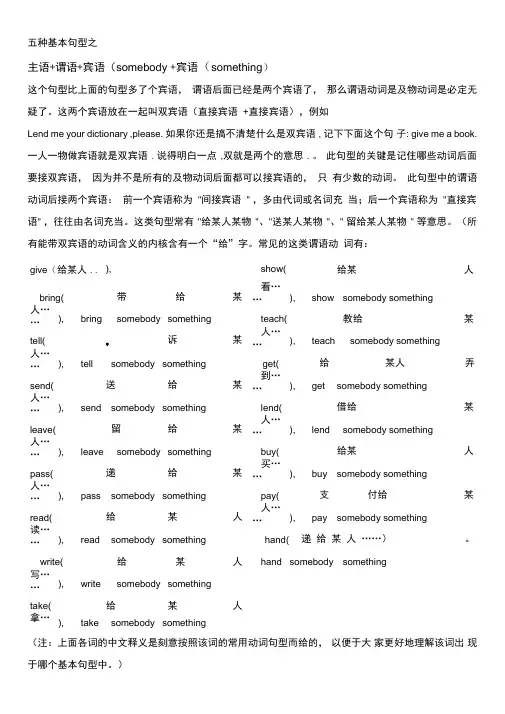
五种基本句型之主语+谓语+宾语(somebody +宾语(something )这个句型比上面的句型多了个宾语, 谓语后面已经是两个宾语了, 那么谓语动词是及物动词是必定无 疑了。
这两个宾语放在一起叫双宾语(直接宾语 +直接宾语),例如Lend me your dictionary ,please. 如果你还是搞不清楚什么是双宾语 , 记下下面这个句 子: give me a book.一人一物做宾语就是双宾语 . 说得明白一点 ,双就是两个的意思 . 。
此句型的关键是记住哪些动词后面要接双宾语, 因为并不是所有的及物动词后面都可以接宾语的, 只 有少数的动词。
此句型中的谓语动词后接两个宾语: 前一个宾语称为 "间接宾语 " ,多由代词或名词充 当;后一个宾语称为 "直接宾语" ,往往由名词充当。
这类句型常有 "给某人某物 "、"送某人某物 "、" 留给某人某物 " 等意思。
(所有能带双宾语的动词含义的内核含有一个“给”字。
常见的这类谓语动 词有:give (给某人 .. ),show(给某人bring(带给某 看…… ),show somebody something人……), bringsomebody somethingteach(教给某tell(告诉某 人…… ),teach somebody something人……), tellsomebody somethingget(给某人弄send(送给某 到…… ),get somebody something人……), send somebody somethinglend(借给某leave(留给某 人…… ),lendsomebody something人……), leavesomebody somethingbuy(给某人pass(递给某 买…… ),buy somebody something人……), pass somebody somethingpay(支付给某read(给某人 人…… ),pay somebody something读……), read somebody somethinghand(递 给 某 人 ……)。
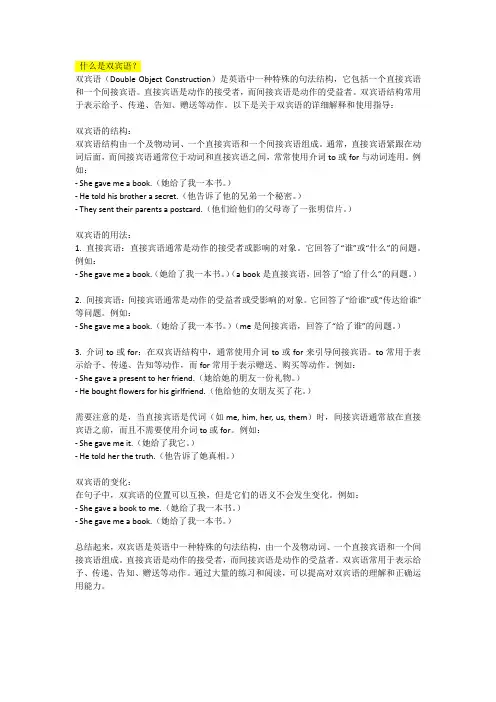
什么是双宾语?双宾语(Double Object Construction)是英语中一种特殊的句法结构,它包括一个直接宾语和一个间接宾语。
直接宾语是动作的接受者,而间接宾语是动作的受益者。
双宾语结构常用于表示给予、传递、告知、赠送等动作。
以下是关于双宾语的详细解释和使用指导:双宾语的结构:双宾语结构由一个及物动词、一个直接宾语和一个间接宾语组成。
通常,直接宾语紧跟在动词后面,而间接宾语通常位于动词和直接宾语之间,常常使用介词to或for与动词连用。
例如:- She gave me a book.(她给了我一本书。
)- He told his brother a secret.(他告诉了他的兄弟一个秘密。
)- They sent their parents a postcard.(他们给他们的父母寄了一张明信片。
)双宾语的用法:1. 直接宾语:直接宾语通常是动作的接受者或影响的对象。
它回答了“谁”或“什么”的问题。
例如:- She gave me a book.(她给了我一本书。
)(a book是直接宾语,回答了“给了什么”的问题。
)2. 间接宾语:间接宾语通常是动作的受益者或受影响的对象。
它回答了“给谁”或“传达给谁”等问题。
例如:- She gave me a book.(她给了我一本书。
)(me是间接宾语,回答了“给了谁”的问题。
)3. 介词to或for:在双宾语结构中,通常使用介词to或for来引导间接宾语。
to常用于表示给予、传递、告知等动作,而for常用于表示赠送、购买等动作。
例如:- She gave a present to her friend.(她给她的朋友一份礼物。
)- He bought flowers for his girlfriend.(他给他的女朋友买了花。
)需要注意的是,当直接宾语是代词(如me, him, her, us, them)时,间接宾语通常放在直接宾语之前,而且不需要使用介词to或for。
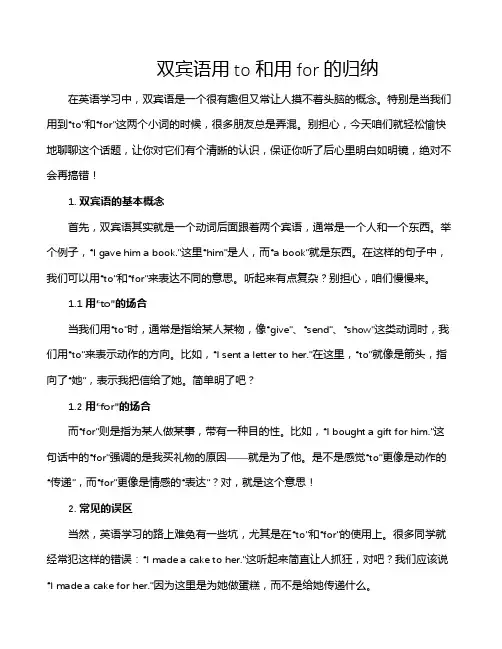
双宾语用to和用for的归纳在英语学习中,双宾语是一个很有趣但又常让人摸不着头脑的概念。
特别是当我们用到“to”和“for”这两个小词的时候,很多朋友总是弄混。
别担心,今天咱们就轻松愉快地聊聊这个话题,让你对它们有个清晰的认识,保证你听了后心里明白如明镜,绝对不会再搞错!1. 双宾语的基本概念首先,双宾语其实就是一个动词后面跟着两个宾语,通常是一个人和一个东西。
举个例子,“I gave him a book.”这里“him”是人,而“a book”就是东西。
在这样的句子中,我们可以用“to”和“for”来表达不同的意思。
听起来有点复杂?别担心,咱们慢慢来。
1.1 用“to”的场合当我们用“to”时,通常是指给某人某物,像“give”、“send”、“show”这类动词时,我们用“to”来表示动作的方向。
比如,“I sent a letter to her.”在这里,“to”就像是箭头,指向了“她”,表示我把信给了她。
简单明了吧?1.2 用“for”的场合而“for”则是指为某人做某事,带有一种目的性。
比如,“I bought a gift for him.”这句话中的“for”强调的是我买礼物的原因——就是为了他。
是不是感觉“to”更像是动作的“传递”,而“for”更像是情感的“表达”?对,就是这个意思!2. 常见的误区当然,英语学习的路上难免有一些坑,尤其是在“to”和“for”的使用上。
很多同学就经常犯这样的错误:“I made a cake to her.”这听起来简直让人抓狂,对吧?我们应该说“I made a cake for her.”因为这里是为她做蛋糕,而不是给她传递什么。
2.1 理解语境要想搞明白用“to”还是“for”,最关键的就是理解语境。
你可以问自己:我是在给某人某物吗?还是为某人做了什么呢?这时候,你的脑袋里就会出现一个小小的分界线,帮助你轻松做出选择。
2.2 习惯积累另外,多读、多听也是必不可少的。
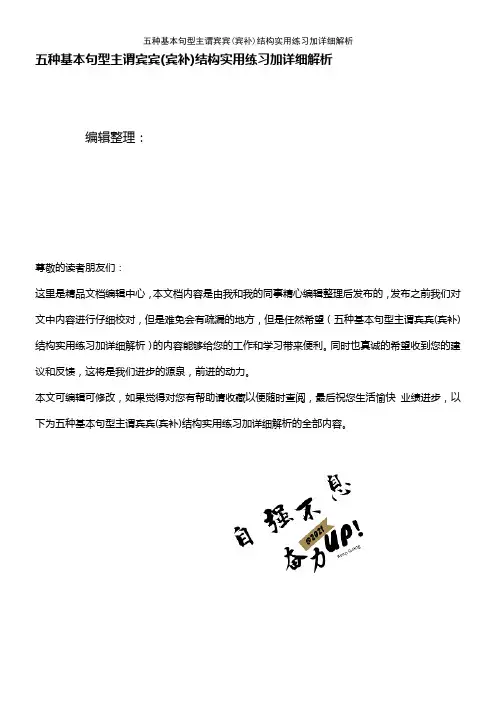
五种基本句型主谓宾宾(宾补)结构实用练习加详细解析编辑整理:尊敬的读者朋友们:这里是精品文档编辑中心,本文档内容是由我和我的同事精心编辑整理后发布的,发布之前我们对文中内容进行仔细校对,但是难免会有疏漏的地方,但是任然希望(五种基本句型主谓宾宾(宾补)结构实用练习加详细解析)的内容能够给您的工作和学习带来便利。
同时也真诚的希望收到您的建议和反馈,这将是我们进步的源泉,前进的动力。
本文可编辑可修改,如果觉得对您有帮助请收藏以便随时查阅,最后祝您生活愉快业绩进步,以下为五种基本句型主谓宾宾(宾补)结构实用练习加详细解析的全部内容。
五种基本句型——主谓宾宾(宾补)结构主语+谓语+宾语(somebody)+宾语(something)主语+谓语+宾语+宾语补足语这个句型的语后面有两个宾语,这两个宾语放在一起叫双宾语(直接宾语+直接宾语)例如:Lend me your dictionary, please.这里“me”和“a book"一人一物做宾语就是双宾语这两个宾语:前一个宾语称为"间接宾语",多由代词或名词充当,通常为“人”;后一个宾语称为"直接宾语”,往往由名词充当,通常为“物”.这类句型常有"给某人某物"、”送某人某物"、"留给某人某物"等意思。
常见的这类谓语动词有:give(给某人……),bring(带给某人……), bring somebody somethingtell(告诉某人……), tell somebody somethingsend(送给某人……), send somebody somethingleave(留给某人……), leave somebody somethingpass(递给某人……), pass somebody somethingread(给某人读……), read somebody somethingwrite(给某人写……), write somebody somethingtake(给某人拿……), take somebody somethingshow(给某人看……), show somebody somethingteach(教给某人……), teach somebody somethingget(给某人弄到……), get somebody somethinglend(借给某人……), lend somebody somethingbuy(给某人买……), buy somebody somethingpay(支付给某人……), pay somebody somethinghand(递给某人……) .hand somebody something注:上面各词的中文释义是刻意按照该词的常用动词句型而给的,以便于大家更好地理解该词出现于哪个基本句型中。
五种【2 】根本句型——主谓宾宾(宾补)构造主语+谓语+宾语(somebody)+宾语(something)主语+谓语+宾语+宾语补足语这个句型的语后面有两个宾语,这两个宾语放在一路叫双宾语(直接宾语+直接宾语)例如:Lend me your dictionary, please.这里“me”和“a book”一人一物做宾语就是双宾语这两个宾语:前一个宾语称为"间接宾语",多由代词或名词充当,平日为“人”;后一个宾语称为"直接宾语",往往由名词充当,平日为“物”.这类句型常有"给或人某物"."送或人某物"."留给或人某物"等意思.常见的这类谓语动词有:give(给或人……),bring(带给或人……), bring somebody somethingtell(告知或人……), tell somebody somethingsend(送给或人……), send somebody somethingleave(留给或人……), leave somebody somethingpass(递给或人……), pass somebody somethingread(给或人读……), read somebody somethingwrite(给或人写……), write somebody somethingtake(给或人拿……), take somebody somethingshow(给或人看……), show somebody somethingteach(教给或人……), teach somebody somethingget(给或人弄到……), get somebody somethinglend(借给或人……), lend somebody somethingbuy(给或人买……), buy somebody somethingpay(付出给或人……), pay somebody somethinghand(递给或人……) .hand somebody something注:上面各词的中文释义是锐意按照该词的常用动词句型而给的,以便于大家更好地懂得该词消失于哪个根本句型中.例如:She brought me a shirt .她给我带来一件衬衣.Pass him the dictionary, please.请将词典递给他.I lend him my bicycle.我把自行车借给他了.五种根本句型之主语+谓语+宾语+宾语补足语语法书上又叫做主语+谓语+复合宾语,这里的复合宾语=宾语+宾语补足语, 宾语补足语:例子:ask somebody to do something (邀请或人做某事)tell somebody to do something (告知或人做某事)want somebody to do something (请求或人做某事)1. I asked him to have dinner.谓语宾语宾语补足语2. He told me to clean the room.谓语宾语宾语补足语3. Tom wanted me to meet him .谓语宾语宾语补足语第一个句子,我邀请他吃饭,他(him)是作邀请(asked)的宾语,假如后面没有to have dinner ,句子意思就不完全,我邀请他,干什么呢?没说清晰,于是就有to have dinner来关心说清晰,是吃饭的,在这里的to have dinner 就是宾语补足语,这是动词不定式短语作宾补.to do 是动词不定式,但是假如动词不定式中的动词带有宾语或者动词不定式中的动词有副词来润饰,这时的动词不定式就成为不定式短语了.比如to do something 就是动词不定式短语,换句话说:这里 to have(动词不定式) to have dinner(动词不定式短语).又比如:to run是动词不定式to run fast 是动词不定式短语).上面的三个句子都是不定式短语作宾语不足语来关心宾语来补充解释.常见宾补的类型:doing \不带to的动词不定式\介词短语\形容词等等.请看下面的例句,留意不雅察划线的部分是有什么作的宾语补足语.:1.I saw a thief stealing something. 我看到一个贼正在偷器械2.He made me go home他让我回家3.Her mother kept her in the room . 她的妈妈让她待在房间里此句型的症结是记住那些动词后面是跟什么样的宾补.比如:我们可以说 ask somebody to do something (to do something 作宾补)我们就不能说 ask somebody doing something下面记住动词后面跟什么样的宾补口诀:1.动词后面是跟带to的动词不定式(动词不定式可以分为带to的动词不定式和不带to的不定式两种,不带to的不定式现实上就是动词本相)作宾补的order somebody to do somethingwant somebody to do somethingtell somebody to do somethinginvite somebody to do somethingask somebody to do somethingbeg somebody to do something(留意上面的有六个单词可以跟动词不定式作宾补,我们可以按照语气的强弱来记忆这几个单词:敕令>请求>告知>邀请>请求>乞求)此外,还有 advise somebody to do somethingallow somebody to do somethingwarn somebody to do somethingteach somebody to do something2. 动词后面可以跟不带to的动词不定式作宾补的口决:一感二听三让五看半关心这里:一感(feel)二听(hear\listen to )三让(let \make\have)五看(see\watch\notice\observe\look at)半关心(help).即: feel hear listen to let make leave somebody do sth see watch notice observe look at help4. 动词后面是跟doing作宾补的,可以借助上面的句子来记忆,上面的单词中除了三让(have\let\make)半关心(help)不能跟dong作宾补之外,其它都是可以的.(即:一感二听五看,现实上它们都属于感官动词)演习四一断定下列句子是主谓+双宾语构造照样主谓+复合宾语,假如是主谓+复合宾语,请指出复合宾语是由什么充当的.1. I watch the boy playing foot ball.2. My good friend told me a story3. Tom lent me a pencil.4. LiLi noticed two dogs fight .5. I looked at her flying a kite .6. Please hand me the paper .7. The lion ordered the hen to give him some eggs.8. He wanted you to go with him.9. Lu Yang told the little boy to go home.10. She asks me to help her . 11. My parents leave me some money .12. Lucy leads me a pencil . 13. Mother got me some tea .14. LiLei found 100 yuan in the room. 15. He showed me her photos .16. The fans made Lin Junjie a famous star.17. Mom let me in. 18. The rich man bought his son an MP4.19. The teacher observes the boy sleep. 20. The teacher made her monitor.21. I saw the baby cry. 22. I paid him three yuan .23. He passed me an eraser. 24. Lucy heard her neighbor singing25. Tom teaches us English. 26. They asked the teacher to explain it again .27. Let me read you his letter . 28. Would you sing us an English song ?29. I will lend you something. 30. Did you notice me leave the house演习四答案1. I watch the boy playing foot ball.我看到谁人男孩在踢足球.主谓+宾语+宾补.playing foot ball做宾补2. My good friend told me a story我的好同伙给我讲了一个故事.主谓+双宾3. Tom lent me a pencil.汤姆借给我一个铅笔.主谓+双宾4. LiLi noticed two dogs fight.李利留意到两个狗在打架.主谓+宾语+宾补,fight做宾补5. I looked at her flying a kite.我看到她在放风筝.主谓+宾语+宾补.flying a kite做宾补6. Please hand me the paper .请递给我一张纸.主谓+双宾7. The lion ordered the hen to give him some eggs.那头狮子敕令那只母鸡给他一些鸡蛋.主谓+宾语+宾补.to give him some eggs做宾补8. He wanted you to go with him.他要你一路跟他去.主谓+宾语+宾补.to go with him做宾补9. Li Yang told the little boy to go home.李扬叫谁人小男孩回家.主谓+宾语+宾补.to go home做宾补10. She asks me to help her .她请我去关心她.主谓+宾语+宾补.to help her做宾补11. My parents leave me some money .我的怙恃亲留给我一些钱.主谓+双宾12. Tom leads me a pencil .汤姆借给我一只铅笔.主谓+双宾13. Mother got me some tea .妈妈给我取了一些茶.主谓+双宾14. LiLei found 100 yuan in the room.李蕾发明有100元在房间里/李蕾在房间里发明了100元.主谓+宾语+宾补.in the room做宾补15. He showed me her photos .他让我看了看她的照片.主谓+双宾16. The fans made Lin Junjie a famous star.那些粉丝们让林俊杰成为一个明星.主谓+双宾17. Mom let me in.妈妈让我进去.主谓+宾语+宾补.in做宾补18. The rich man bought his son an MP4.谁人有钱人给他的儿子买了一个MP4.主谓+双宾19. The teacher observes the boy sleep.谁人先生不雅察到谁人男孩睡觉了.主谓+宾语+宾补.sleep做宾补20. The teacher made her monitor.先生让她做班长.主谓+双宾21. I saw the baby cry.我看到谁人男孩哭了.主谓+宾语+宾补.cry做宾补22. I paid him three yuan .我付给他三元.主谓+双宾23. He passed me an eraser.他递给我一个橡皮.主谓+双宾24. She heard her neighbor singing她听到她的邻人在唱歌.主谓+宾语+宾补.singing做宾补25. Tom teaches us English.汤姆教我们英语.主谓+双宾26. They asked the teacher to explain it again .他们请先生在解释一遍.主谓+宾语+宾补.to explain it again做宾补27. Let me read you his letter .让我给你读读他的信.主谓+双宾28. Would you sing us an English song ?你可以给我们唱支英文歌吗?主谓+双宾29. I will lend you a book .我将借给你`一本书.主谓+双宾30. Did you notice me leave the house?你留意到我分开房子吗?主谓+双宾。
基本用法宾语从句在复合句中用作宾语的从句叫宾语从句结构:主语+谓语+宾语(陈述句语序)、从属连词。
连接宾语从句的从属连词主要有that,if,whether,和特殊疑问词(what,how,where,when等)。
that引导表示陈述句的宾语从句,if和whether,whether...or not引导表示“是否”的一般疑问句的宾语从句。
He told me (that )he would go to college the next year.他告诉我他明年上大学。
I don’t know if there will be a bus any more.我不知道是否还会有公交车。
Nobody knew whether he could pass the exam.没有人知道他是否会通过考试。
Teachers were asking me whether I had gone there or not at that time.那时老师们在问我是否曾去过那里。
宾语从句的基本用法名词性从句在复合句中作谓语动词、非谓语动词、介词的宾语时被称为宾语从句。
高考中常见的宾语从句包括以下几种情况:1. that引导的宾语从句(that经常可以被省略),例如:His mother said (that) Saul Grant was a music critic. 他母亲说索尔•格兰特是个音乐评论家。
把握that引导的宾语从句要注意以下特殊情况:(1) 宾语从句(通常是由that引导的宾语从句)常置于句末并用it作形式宾语。
例如:We think it important that Mary should tell the truth. 我们认为玛丽说出实情很重要。
// I have made i t clear that we’ll sign the contract with your company. 我已讲得很清楚:我方将与贵公司签订这个合约。
宾语代词:直接宾语人称代词词形:me(m’)我,te(t')你,le(l’)他、它, la(l’)她、它,nous我们, vous 你们、您,les他们、她们、它们,le 它(中性代词)用法:1.代替人或者物,在句子中作直接宾语。
一般放在动词之前,并要和被代替的名词性、数一致:例句:Elle m’attend devant le cinéma.Je vous connais.As—tu vu mes amies ? Oui, je les ai vu es.2.在肯定命令句中,直接宾语人称代词要放在动词后面,用连字符连接,me,te 并要改为重读人称代词moi, toi.例句:Aidez—moi ! 帮助我吧!Aidez—les !帮助他们吧!在否定命令句中,人称代词仍放在动词前面.例句:Ne m'aidez pas。
Ne les aidez pas.间接宾语人称代词词形:me(m’)我,te(t’)你, lui他、她、它, nous我们, vous你们、您,leur他们、她们、它们用法:1.代替以介词à引导的名词或人称代词,一般应放在有关动词的前面。
例句:Est—ce que tu écris souvent des lettres à tes parents ?Oui, je leur écris souvent.des lettres。
2.在肯定命令句中,间接宾语人称代词放在动词后面,用连接符连接,me,te 要改用重读人称代词 moi, toi。
Donne—moi ces livres。
Donne-lui ce stylo.Donne—nous ces cahiers。
Donne—leur ces montres.自反人称代词词形:me(m’)我,te(t’)你,se他、她、它,nous 我们,vous你们,se他们、她们、它们用法:1.自反人称代词和动词组成代动词,放在动词前面,一般做“自己"、“互相"解释.如:je me lave. Tu te lève。
动词不定式(the infinitive)用法梳理(1)定义:动词不定式是由“不定式符号to+动词原形”构成的一种非谓语动词结构。
结构:“to +动词原形”,即“to do”,其中 to不是介词,而是动词不定式的符号,动词不定式没有人称和数的变化。
否定形式为:not / never + to do句法功能:一、用作主语○多数情况用it作形式主语,把真正的主语——动词不定式置于句末,特别是不定式短语较长时。
. To learn English well is not easy. = It’s not easy to learn English well.1. I t is our duty to try our best to deal with these problems.2. The head teacher said it was necessary to talk with his mother.○动词不定式作主语,谓语动词用第三人称单数形式。
To see is to believe.(眼见为实;百闻不如一见)【翻译】成为一个老师是我的梦想。
.○疑问词+不定式短语作主语可置于句首。
How to learn English well is important.补充:用it作形式主语,把真正的主语不定式置于句后,常用于下列句式中。
如:① It+be+名词+to do It's our duty to take good care of the old.② It takes sb + some time +to do How long did it take you to finish the work③ It+be+形容词+for sb+to do 逻辑主语It is difficult for us to finish writing the composition a quarter of an hour.④ It+be+形容词+of sb+to do “It is stupid of you to write down everything”, the teacher says.注意:在③中,常用表示客观情况的形容词,如:difficult, easy, hard, important, impossible, necessary 等;在④中,常用careless, clever, good, foolish, honest, kind, lazy, nice, right, silly, stupid,wise等表示赞扬或批评的词,强调对人的评价。
双宾语结构to 与for的用法To和for是常用的双宾语结构中的介词,它们在句子中起到连接不同成分的作用。
在语法上,to和for有着不同的用法和规则,需要根据具体情境来正确使用。
在下文中,将逐一介绍它们的用法和例句,并对比它们之间的差异。
首先,让我们来看一下to的用法。
To在双宾语结构中通常用来表示动作的接受者,即给予某人或某物。
例如:He gave a present to his friend.(他把礼物给了他的朋友。
)在这个例句中,to表示了动作的接受者,即his friend。
另外,to也可以用来表示目的或原因。
例如:We went to the beach to relax.(我们去海滩是为了放松。
)在这个例句中,to表示了动作的目的,即relax。
除了以上两种情况,to在双宾语结构中还可以表示其他用法。
例如:She read the book to her children.(她给她的孩子们读故事书。
)在这个例句中,to表示了动作的传递对象,即her children。
另外,to还可以表示时间、比较、归属等不同的意义。
接下来,让我们来看看for的用法。
For在双宾语结构中通常用来表示目的、目标或理由。
例如:I bought a gift for my mom.(我给我妈妈买了一个礼物。
)在这个例句中,for表示了动作的目的,即my mom。
另外,for也可以用来表示对象的利益或帮助。
例如:I made a cake for my friend.(我给我的朋友做了一个蛋糕。
)在这个例句中,for表示了对象的利益,即my friend。
除了以上两种情况,for在双宾语结构中还可以表示其他用法。
例如:She is saving money for a new car.(她在为一辆新车而省钱。
)在这个例句中,for表示了动作的目的,即a new car。
另外,for还可以表示代替、交换、表示持续时间等不同的意义。
练习四
一 判断下列句子是主谓+双宾语结构还是主谓+复合宾语,如果是主谓+复合宾语,请指出复合宾语是由什么充当的。
1. I watch the boy playing foot ball.
2. My good friend told me a story
3. Tom lent me a pencil.
4. LiLi noticed two dogs fight .
5. I looked at her flying a kite .
6. Please hand me the paper .
7. The lion ordered the hen to give him some eggs.
8. He wanted you to go with him.
9. Lu Yang told the little boy to go home.
10. She asks me to help her .
11. My parents leave me some money .
12. Lucy leads me a pencil .
13. Mother got me some tea .
14. LiLei found 100 yuan in the room.
15. He showed me her photos .
16. The fans made Lin Junjie a famous star.
17. Mom let me in.
18. The rich man bought his son an MP4.
19. The teacher observes the boy sleep.
20. The teacher made her monitor.
21. I saw the baby cry.
22. I paid him three yuan .
23. He passed me an eraser.
24. Lucy heard her neighbor singing
25. Tom teaches us English.
26. They asked the teacher to explain it again .
27. Let me read you his letter .
28. Would you sing us an English song ?
29. I will lend you something.
30. Did you notice me leave the house